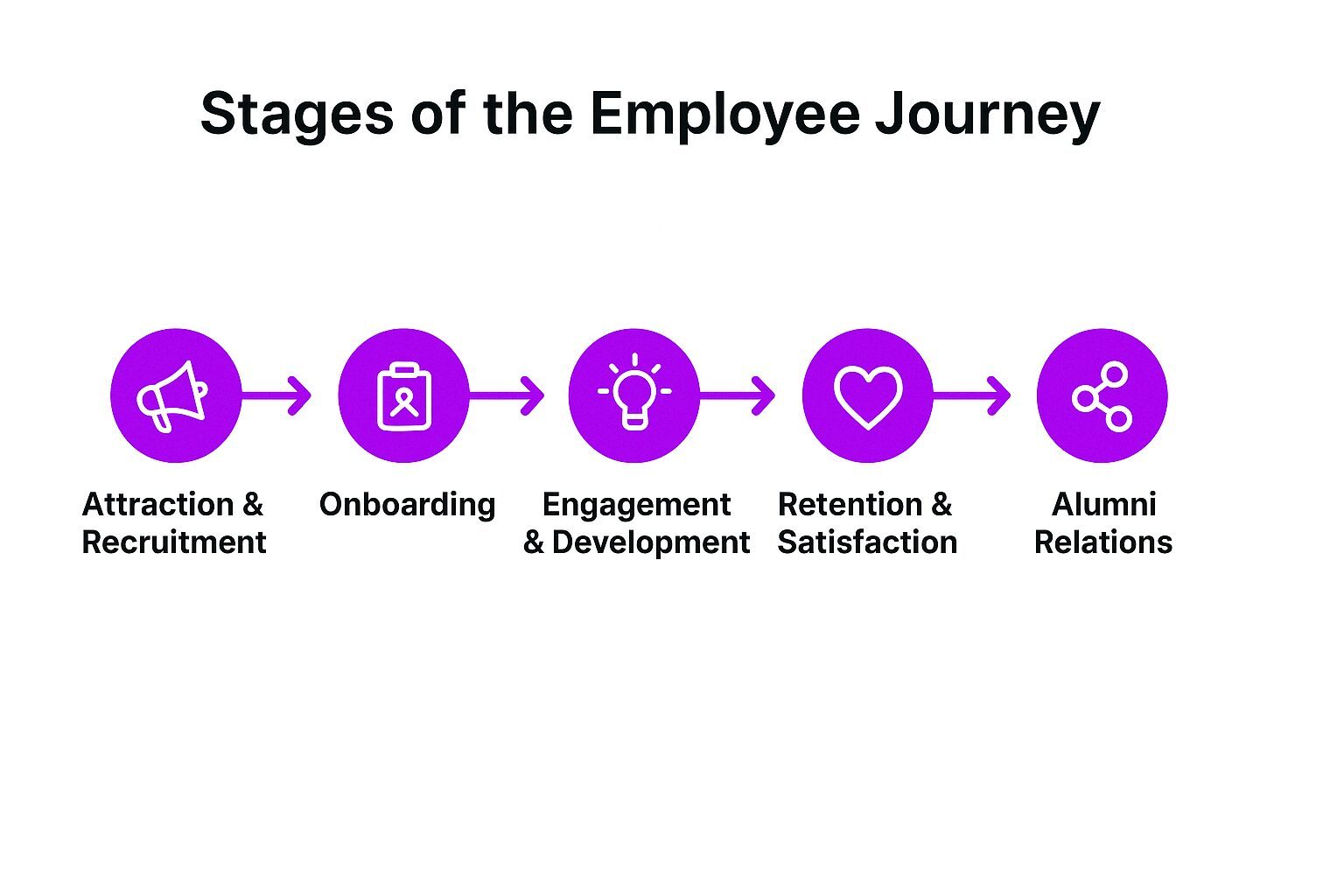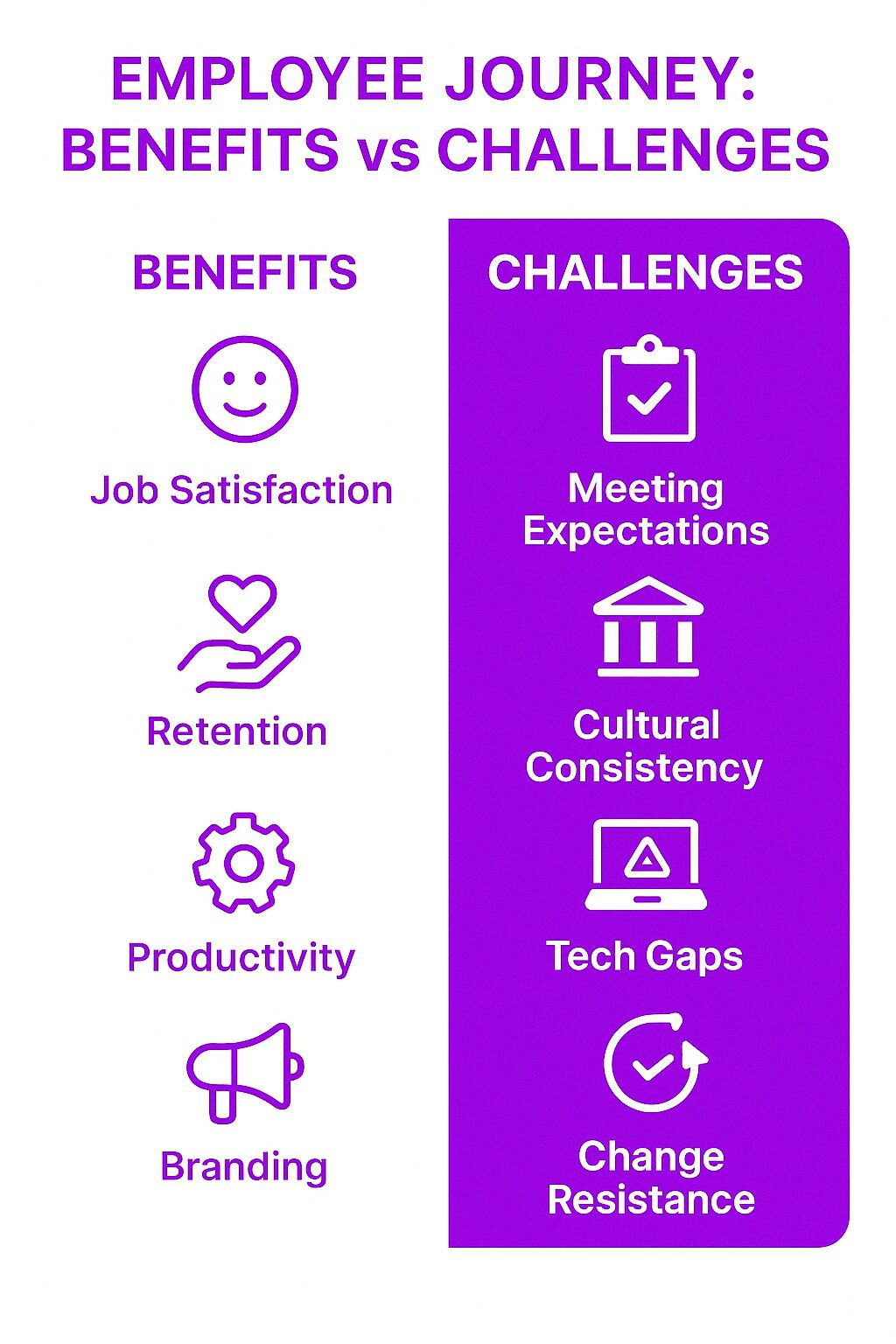What is the Employee Journey?
The employee journey is the complete experience an employee has while working at a company. It starts from the first interaction during recruitment and ends when they leave. Every step, interaction, and milestone in between shapes how an employee feels about their job, the organization, and their future within it.
The employee journey mapping process involves outlining the procedural steps to understand and improve the employee experience from hiring to departure. This includes defining employee types for targeted mapping and gathering data through various methods to enhance the overall journey and identify areas for improvement.
This is different from the employee lifecycle, which is a structured series of steps—hiring, onboarding, training, retention, and offboarding. The employee journey is about personal experience, emotions, and engagement at each stage. It focuses on how employees perceive their work environment and their opportunities for growth.
Definition and Importance
Employee journey mapping is a strategic process used to visualize and analyze every interaction and touchpoint an employee has with an organization throughout their tenure. It is essential for understanding the employee experience, which is critical for business success. By mapping the employee journey, organizations can identify areas for improvement, enhance the employee experience, and ultimately drive better organizational outcomes.
Key Stages of the Employee Journey
Attraction and Recruitment
The journey starts before an employee even applies. Employer branding plays a crucial role in attracting top talent. Companies that showcase a strong workplace culture, clear values, and career growth opportunities tend to draw in high-quality applicants.
-
Job descriptions should be clear and transparent.
-
Application processes should be straightforward and user-friendly.
-
Timely communication with candidates helps set expectations.
Onboarding
First impressions matter. A well-structured onboarding process makes employees feel welcomed and prepared. Companies should focus on:
-
Pre-boarding: Sending new hires materials to familiarize themselves with the company.
-
First-day experience: Having a clear schedule and introductions planned.
-
Mentorship: Assigning a buddy or mentor for guidance.
-
Training: Providing clear expectations and tools to succeed.
A strong onboarding process increases employee confidence and reduces early turnover.
Engagement and Development
Once settled, employees want to feel valued and see opportunities to grow. Engagement comes from meaningful work, professional development, and a sense of belonging. Providing professional development opportunities is a key factor in employee satisfaction and retention.
-
Regular feedback and performance check-ins help employees understand how they are doing.
-
Training programs and learning opportunities keep skills sharp.
-
Career growth paths should be well-defined and supported by leadership.
Retention and Satisfaction
Happy employees stay longer. Companies that prioritize retention focus on work-life balance, recognition, and a supportive culture. Understanding employees’ experiences through the lens of an employee journey map can clarify different stages in an employee’s career, illustrating how the experience evolves from hiring to departure.
-
Competitive compensation and benefits play a role, but so does flexibility.
-
Recognition programs, such as employee awards and bonuses, keep morale high.
-
Leadership and management should foster open communication and a sense of trust.
Offboarding and Alumni Relations
An employee’s journey doesn’t end when they leave. Offboarding is an opportunity to leave a lasting positive impression.
-
Exit interviews provide insights into workplace improvements.
-
Knowledge transfer ensures smooth transitions.
-
Keeping in touch with former employees builds an alumni network, which can lead to future collaborations or rehiring.
Why the Employee Journey Matters
A well-designed employee journey benefits both the individual and the company. Employees who feel supported and valued perform better and are more likely to stay. Organizations that invest in improving the journey see lower turnover, higher engagement, and a stronger employer brand. Human resources professionals play a crucial role in enhancing the employee journey, especially during times of high turnover, by focusing on retention and talent acquisition strategies.
Benefits
-
Increased job satisfaction and motivation.
-
Higher productivity and performance.
-
Stronger company culture and reputation.
-
Lower turnover and hiring costs.
Challenges
-
Ensuring a consistent experience across different teams.
-
Meeting diverse employee expectations.
-
Keeping up with changing workforce trends and technology.
Employee Journey Mapping
One way to improve the employee journey is through journey mapping. This process helps organizations identify pain points and opportunities for improvement. Recognizing employee personas is crucial to create tailored experiences that accommodate the unique paths and requirements of different roles within the organization.
Benefits and Process
Employee journey mapping offers numerous benefits, including improved employee service, optimized HR processes and workflows, identified opportunities to lower costs with AI-powered self-service solutions, boosted employee engagement, personalized employee experiences, strengthened diversity, equity, inclusion, and belonging, and streamlined onboarding and offboarding. The process involves creating a comprehensive view of the employee lifecycle, highlighting key interactions and experiences. It requires gathering feedback and data, identifying workplace personas, and visualizing the employee journey map.
How to Map the Employee Journey
-
Identify the key touchpoints employees experience.
-
Gather feedback from employees through surveys and interviews.
-
Analyze how employees feel at each stage.
-
Make necessary improvements based on data.
-
Continuously update and refine the journey map.
Companies that take the time to map the employee journey create a more engaged and satisfied workforce.
Identifying Workplace Personas and Gathering Feedback
Identifying workplace personas is essential for creating effective employee journey maps. Workplace personas are unique roles within the organization, and each persona requires a tailored employee journey map. Gathering feedback and data is also crucial for creating effective employee journey maps. Feedback and data can be collected through various methods, including surveys and interviews. Qualitative and quantitative data are both essential for understanding the employee experience.
Practical Tips for Improving the Employee Journey
-
Use HR technology to streamline processes and improve communication.
-
Create a culture of feedback where employees feel heard and valued.
-
Personalize career development plans to align with employee goals.
-
Offer flexible work arrangements to support work-life balance.
-
Regularly measure engagement and adjust strategies accordingly.
-
Emphasize the importance of onboarding processes in integrating new hires into the organization and ensuring their success from day one.
Related Concepts
Employee Lifecycle
A structured framework that includes hiring, training, retention, and departure.
Employee Engagement
The emotional commitment employees have to their work and organization.
Employer Branding
How a company markets itself to potential and current employees.
Employee Experience
The sum of all interactions employees have with their workplace.
The Interplay Between Culture and Experience
Company culture plays a significant role in shaping the employee experience. A positive company culture can lead to increased employee satisfaction, engagement, and retention, while a negative company culture can lead to decreased employee satisfaction, engagement, and retention. Employee journey mapping can help organizations identify areas for improvement in their company culture and create a more positive and inclusive work environment. By prioritizing employee experience and company culture, organizations can create a competitive edge in the talent search and drive better organizational outcomes.
Real-World Examples
Tech Industry
Companies like Google and Microsoft invest heavily in employee experience. From flexible work options to structured career growth plans, they prioritize creating a journey that keeps employees engaged.
Retail and Hospitality
Brands like Starbucks and Ritz-Carlton focus on employee training and recognition to keep their teams motivated and customer-focused.
Healthcare and Manufacturing
Industries that rely on skilled professionals invest in structured onboarding and ongoing training to retain top talent.
Conclusion
The employee journey is more than just a series of steps—it’s the experience that shapes how employees feel about their work. Companies that prioritize a positive employee journey see better engagement, retention, and overall performance. Investing in improving the employee experience benefits both employees and the organization as a whole.








